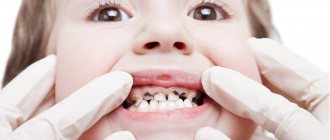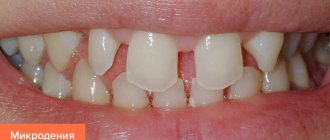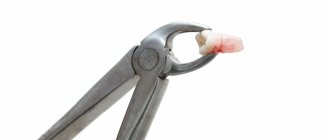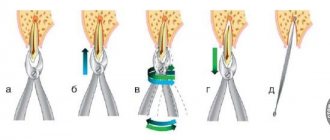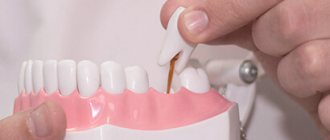The loss of the first milk tooth is a new and important stage in the physiological development of a child. After all, baby teeth fall out when the rudiments of permanent teeth are ready to grow . If the change of teeth goes according to schedule, and the child’s teeth are healthy, he has every chance of getting the same healthy permanent teeth. But very often baby teeth have to be removed prematurely due to untimely treatment of caries and its complications, as well as due to injuries. Many parents think that these are just temporary teeth and nothing to worry about, but this is not entirely true .
Indications for removal of baby teeth
In the absence of pathologies and good dental health, the renewal of the child’s bite begins at approximately the age of 5-7 years. The permanent molars are already ready to replace the baby teeth, so the latter become mobile and often fall out on their own.
The ideal scenario makes everyone happy, but sometimes the removal (extraction) of baby teeth is an objective necessity. Indications are determined by the dentist:
- Loose baby teeth. The strong mobility of the changing tooth bothers the child. Unpleasant sensations occur when talking or eating. There is a danger of gum inflammation.
- Supernumerary tooth. An extra unit interferes with the formation of a correct bite, so after consultation with an orthodontist it is often recommended to be removed.
- Beginning of permanent molar tooth eruption. In this case, the baby tooth becomes a nuisance, which it is advisable to remove as soon as possible.
- Severe tooth decay due to deep caries, pulpitis or periodontitis. The dentist will make every effort to save the baby tooth, but in case of serious damage to the crown, there is only one solution - removal.
- Crack and mechanical damage. A crown split, root fracture and other consequences of severe trauma are a reason to remove the destroyed unit.
- Bite correction. To ensure the correct positioning of teeth in the jaw, it is often necessary to forcefully remove individual units. But this is done after consulting an orthodontist.
- Inflammatory processes in the area of the tooth root. Granuloma, fistula or cyst is a threat to the health of the root system of permanent elements. Usually, the doctors at AzaBuka Pediatric Dentistry manage to cure the inflammation. If not, removal is inevitable.
The reasons for the removal of temporary teeth can be very different, but modern pain relief techniques make the extraction procedure painless and comfortable for the child. It is best to schedule an adaptation visit as your first appointment. If the baby is already familiar with doctors, then you can immediately make an appointment with a dental surgeon.
Adaptation in dentistry is a series of introductory sessions for children, during which children are introduced to the work of dentists, equipment, and tools. Communication takes place in a fun, playful way with the display of informational cartoons, fairy tales, and interesting dental models. After adaptation techniques, children cease to be afraid of doctors and willingly agree to all types of treatment.
Function of primary teeth
Primary teeth are temporary structures in the body. The first very small teeth erupt 6 months after the baby is born, when his jaws are not yet fully formed. As a result, the baby’s feeding style changes – from sucking to chewing. Chewing movements promote the development of jaws and facial muscles. The correct proportional relationship between the parts of the facial skeleton is formed.
The bones under the roots of primary teeth undergo successive stages of maturation of their permanent counterparts. From the age of six, baby teeth begin to fall out and are replaced by larger permanent teeth. In the jaw bones, a synchronous process of resorption of milk roots and advancement of permanent teeth to the alveolar ridge occurs. The last chewing milk tooth falls out at 12-14 years of age.
Is it painful to remove a child's baby tooth? Anesthesia decides everything!
The question of tooth pain relief during extraction is the most frequently asked question by parents. The wishes of adults vary: some want extraction without medications, others insist on full anesthesia. AzaBuka provides several anesthesia methods for children, and when selecting, the doctor always focuses on the individual characteristics of young patients.
In rare cases, they do without pain relief. This is real if the baby tooth is very mobile, and its permanent replacement is already emerging through the gums. In this case, the doctor removes the tooth during an examination of the oral cavity, and the child does not even notice the manipulation. There is simply no point in worrying about whether it is painful to remove a baby tooth in children, but such techniques are rare.
Plaksina Margarita
“One young gentleman had his upper tooth so loose that it was turning in all directions. But it didn't fall out. The boy did not let his parents pull the tooth, but he allowed himself to be examined at the reception and quite willingly opened his mouth. Imagine his surprise when I put the pulled out tooth on his palm literally a minute later. He left happy - with a reward for courage and a milk tooth in his hand.”
Most often, dentists resort to local or thorough anesthesia - they use one of the types of modern anesthesia:
- Superficial. The doctor treats the gums with a special gel that gives a slight freeze. This is done for easy removal of highly mobile teeth or at the site of a future anesthetic injection.
- Local (infiltration). To administer the anesthetic, the doctor uses a syringe with a very thin needle, so the discomfort is minimal. The selection of the drug is carried out in the presence of parents to eliminate the minimal likelihood of an allergic reaction.
- Sedation, shallow sleep. The technique is becoming increasingly popular - both children and adults enjoy it equally. Using an inhalation mask, the child is offered to breathe a special gas - a mixture of nitrous oxide and oxygen. The relaxing effect puts the patient into a state of semi-sleep. The baby understands everything, can follow the doctor’s requests, but does not panic, is not nervous or worried.
The dangers of early absence of baby teeth
The dentition in children consists of a certain number of teeth, and if it is disrupted ahead of time, this can disrupt the formation of a correct bite. This happens because nearby milk teeth may shift to the place of the missing one, which means that the permanent teeth will begin to grow unevenly .
The absence of baby teeth complicates the process of chewing and biting food, and also makes it difficult for a child to develop correct sound production and diction.
In addition, the absence of a tooth does not look aesthetically pleasing and can lead to psychological problems for the child and low self-esteem.
General anesthesia.
Removal or treatment of teeth in a dream is prescribed for certain indications. The appointment is carried out under the supervision of an anesthesiologist with the mandatory use of monitoring equipment.
Dolotova Marina
“Is it painful to remove a baby tooth for a child under sedation - if it doesn’t wobble? Absolutely not. Usually during the appointment, the children watch cartoons while I carefully remove the tooth. And before that, we play superheroes with them and be sure to try on a real mask - a prototype of the Iron Man helmet!”
Indications and contraindications for molar tooth extraction
Reasons for removing a molar tooth may be:
- purulent periostitis;
- abscess;
- phlegmon;
- large tumor in the tooth area;
- purulent periodontal disease;
- the presence of a cyst in the area of the diseased tooth;
- exposed pulp;
- longitudinal tooth fracture;
- critical tooth decay;
- critical tooth curvature;
- disease of the dental bone tissue;
- sinusitis.
The following reasons are contraindications to the removal of molars:
- acute heart diseases;
- acute viral diseases;
- flu;
- angina;
- renal failure;
- pancreatitis;
- hepatitis;
- acute diseases of the nervous system;
- oncological diseases
- initial and final stages of pregnancy;
- stomatitis;
- gingivitis
- general degeneration of the body;
- alcohol poisoning.
Removal of molars during pregnancy
Let us say right away that any surgical intervention during pregnancy is extremely undesirable. If a molar tooth hurts at this time, then ideally it would be best to simply heal it. Unfortunately, sometimes this is no longer possible and the diseased tooth has to be removed.
It is highly undesirable to remove molars in the first and last months of pregnancy. It is at this time that the fetus is most vulnerable.
If it is possible to postpone the removal of a molar until the birth of the child, then this is exactly what should be done.
Under no circumstances should you hide your pregnancy from your dentist. On the contrary, this should be said immediately. In this case, the doctor will select a harmless anesthetic that will not cross the placental barrier.
If a pregnant woman is facing a complex molar tooth extraction, then this should only be done in a hospital setting. After removal, the patient should be under medical supervision for at least two to three days. This is due to the fact that very often, after the removal of a molar, pregnant women experience a sharp increase in body temperature, and this is extremely harmful for the fetus.
How to properly prepare a child for tooth extraction in pediatric dentistry?
- A brave child is one who is familiar with the place and situation, so parents need to try to ensure that the first visit to the dental clinic is not associated with treatment, much less tooth extraction and pain. Go with your child to the dental clinic for preventive examinations, children's parties, which we regularly hold, take your child with you when you go to have your teeth treated.
- A good, cozy clinic is not a dream today, but an accessible reality. Go to the clinic yourself without your child, meet the doctor. The atmosphere should be calm, the space should be thought out for small patients. And, of course, no screaming or crying behind office doors.
- Never frighten your child with the dentist or doctors in general, and do not be afraid of them yourself - children subtly sense the mood of their parents.
- Ask your doctor whether it is better to leave your child alone or be present during the procedure. NEVER leave your child alone at the dentist's office if this is their first appointment with the dentist.
- Do not shame your child in the dentist's chair, do not blackmail him with a gift or threaten him with punishment. Introduce him to the doctor and help establish contact between them, using the child’s natural curiosity - he should be interested, not scared.
Removal technique
When deciding how to extract a baby tooth, dentists look at the degree of its mobility and location. The intervention is carried out very carefully. This is due to some structural features of children's teeth. For example, they have very thin and very long alveolar walls, and short roots. Therefore, when gripping, it is important not to press too hard to prevent the crown from cracking.
Particular attention is paid to the issue of selection of anesthesia. For severe mobility, a local application is suitable. It involves treating the gums in the area where the affected unit is located. If the loosening is very weak or completely absent, an injection is given to achieve a stronger and more lasting anesthetic effect.
What to do after a child’s tooth extraction?
- Make sure that the child spits out the tampon that was placed after removal after 15-20 minutes.
- After removal, a blood clot should remain in the hole, which protects it from inflammation. There is no need to clean the hole from blood, rinse the mouth, the child should not touch the removal site with hands or objects.
- If the child has been given anesthesia, explain to the child that he should not bite on the numb side until the feeling of cold and pins and needles goes away.
- Feed your baby only warm, soft food for several days.
- Maintain good hygiene; brushing your teeth is not only possible, but also necessary, with a soft toothbrush, carefully avoiding the extraction site.
- If the tooth extraction was difficult, then try to limit the child’s physical activity so as not to provoke bleeding.
Molar removal technology
Before proceeding with the removal of a molar, the doctor must make sure that there is no curvature of the roots. For this, an x-ray is taken. If the roots are not bent, the patient is given an anesthetic injection. After 10 minutes, the tooth can be removed.
First, the dentist carefully separates the gum from the body of the tooth. Then he grabs the tooth with pliers and begins to swing it and rotate it at the same time. After several such manipulations, the doctor pulls the tooth out of the alveoli.
In this sequence, both the upper and lower root teeth are removed. However, it is somewhat more difficult to grasp the upper molars with forceps.
Sometimes, when removing a molar, the doctor must first cut it into two or three parts and then pull out each part separately. This usually happens when the roots are bent.
In case of severe curvature of the roots, when they intertwine with the roots of neighboring teeth, removal must be done in fragments and under general anesthesia. In this case, the doctor completely exposes the gum around the diseased tooth.
If there is a cyst in the area of a diseased molar, the doctor is required to be highly qualified. This removal is done under both local and general anesthesia.
Two days after the removal of a molar, the patient must visit the dentist again to take an x-ray. This is necessary to ensure that all tooth roots have been removed.
Procedure
A pediatrician should remove children's teeth, since you need to know the structural features of the children's dental system, as well as the psychology of children. If contact is not found with the patient, then treatment will turn into torture, or even become completely impossible.
Extraction of a dental unit is carried out in stages:
- perform anesthesia with local anesthetics, sedation or anesthesia, the first two methods are combined;
- the oral cavity in the area of surgery is treated with an antiseptic;
- apply forceps to the crown, dislocate and remove the tooth from the socket;
- treat the wound with antiseptic agents;
- check for fragments using x-rays;
- If the bleeding does not stop, hemostatic drugs are used.
How much removal costs depends on the complexity of the procedure and additional services. In pediatric dentistry, the main priorities are safety, psychological comfort and painless treatment.
Pain relief options:
- Double local anesthesia. First, the pain is numbed by application of gels and sprays, and when the sensitivity decreases, an injection is given.
- Sedation. Increased anxiety and fear can be eliminated with the help of oxygen sedation with nitrous oxide (ZAX). The baby falls into a relaxed state, half asleep. At the same time, he does not lose contact with the doctor, can answer questions and perform simple actions. The advantage of the method is absolute safety. If complex removal is required, treatment during sleep using intravenous drugs Dexdor or Propofol is recommended. In this case, the child falls asleep and does not see or hear the surgeon working.
- Anesthesia. It is used in case of a long painful procedure (removal of a cyst, opening of an abscess, etc.), as well as in the presence of dental phobia, Down syndrome, other hereditary syndromes, increased gag reflex, allergies to local anesthetics, under the age of three years. The child falls into a deep medicated sleep. General anesthesia is performed with the inhalation drug Sevoran and its analogues.
